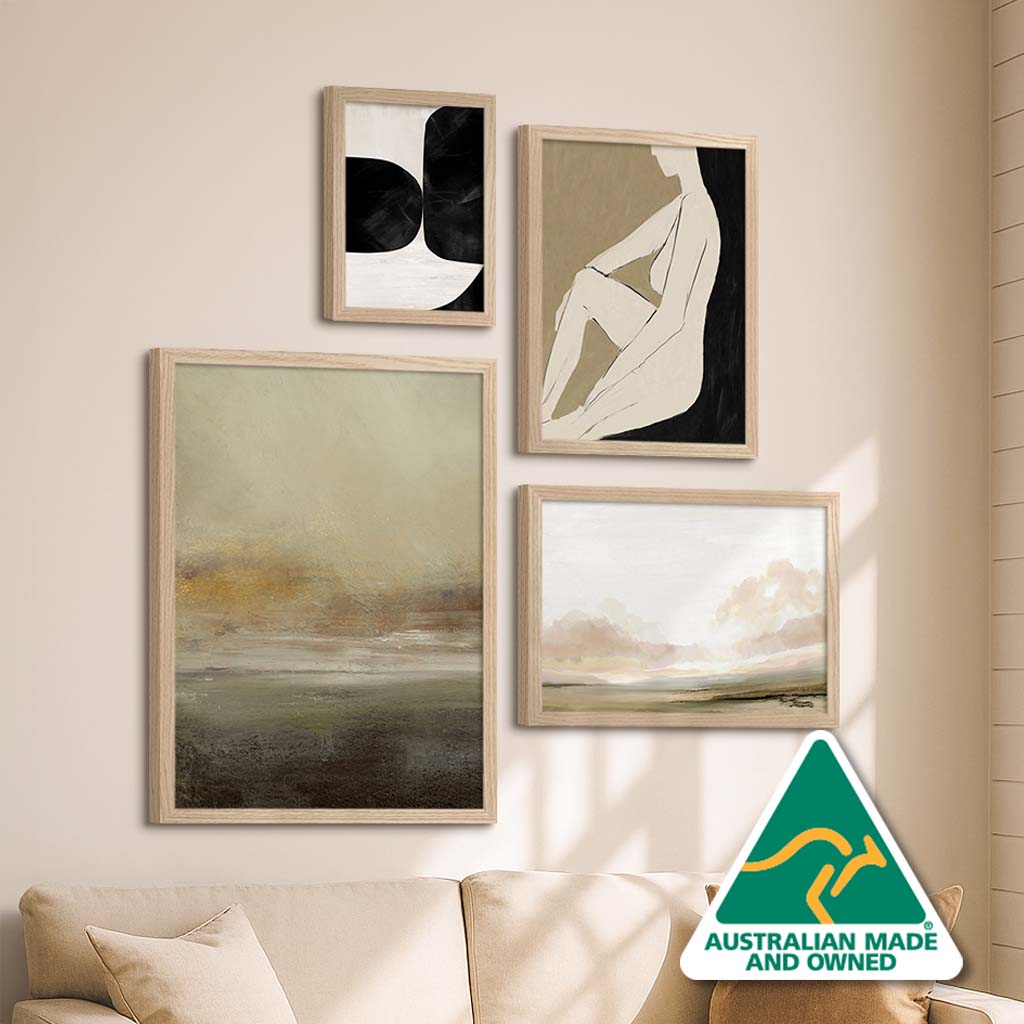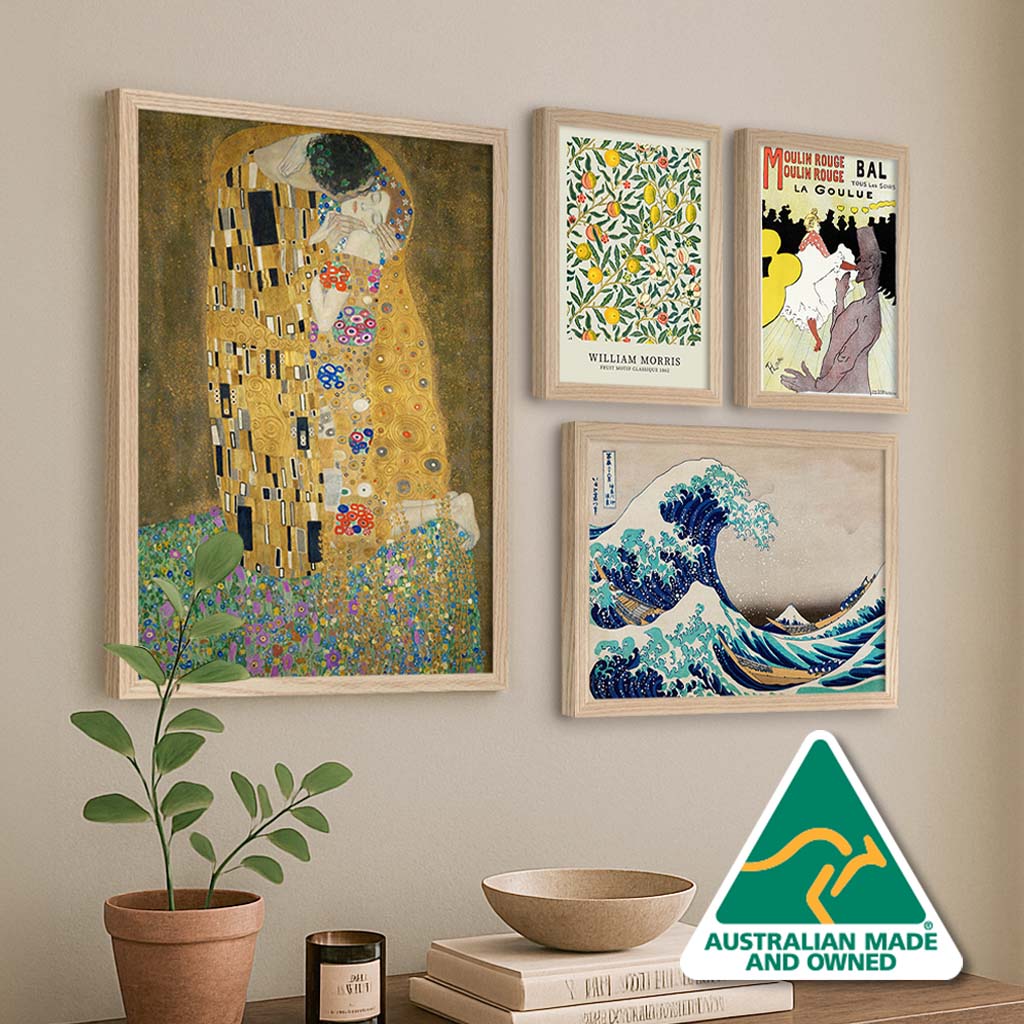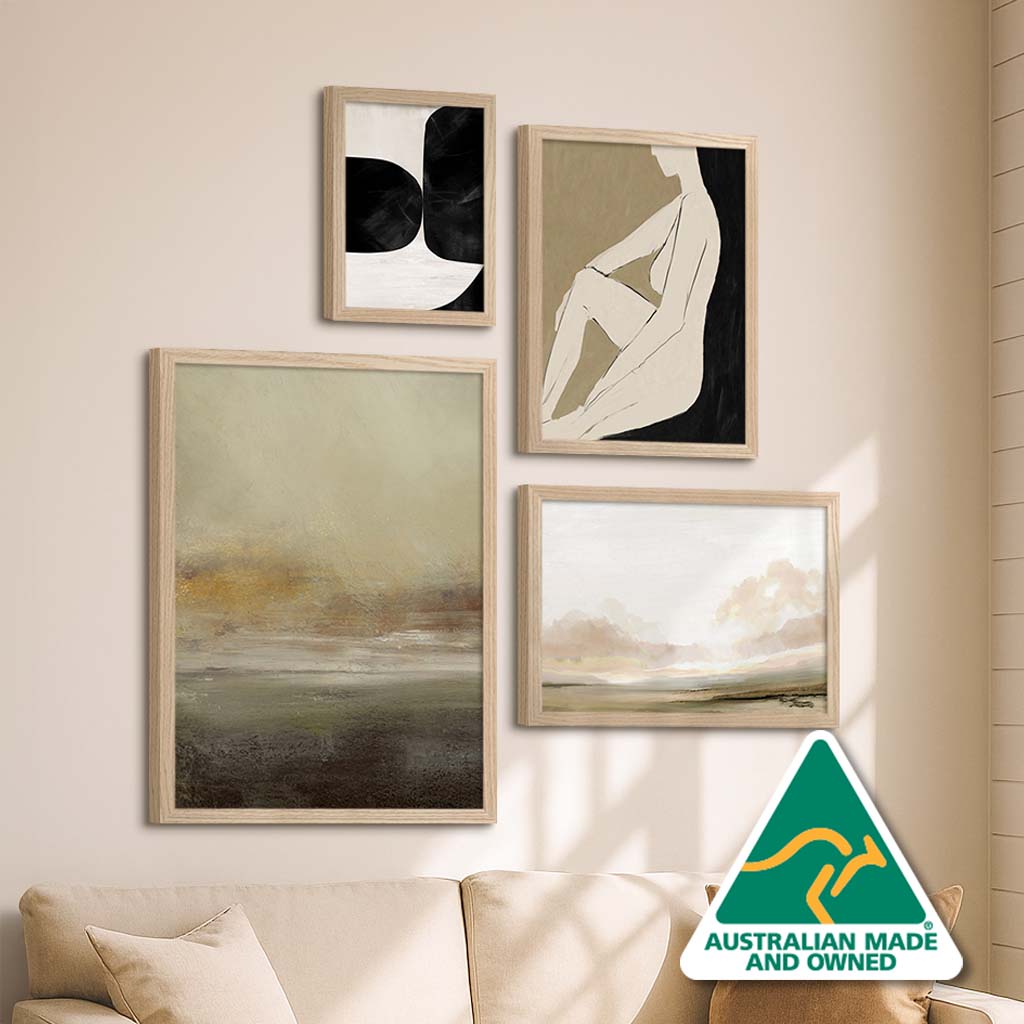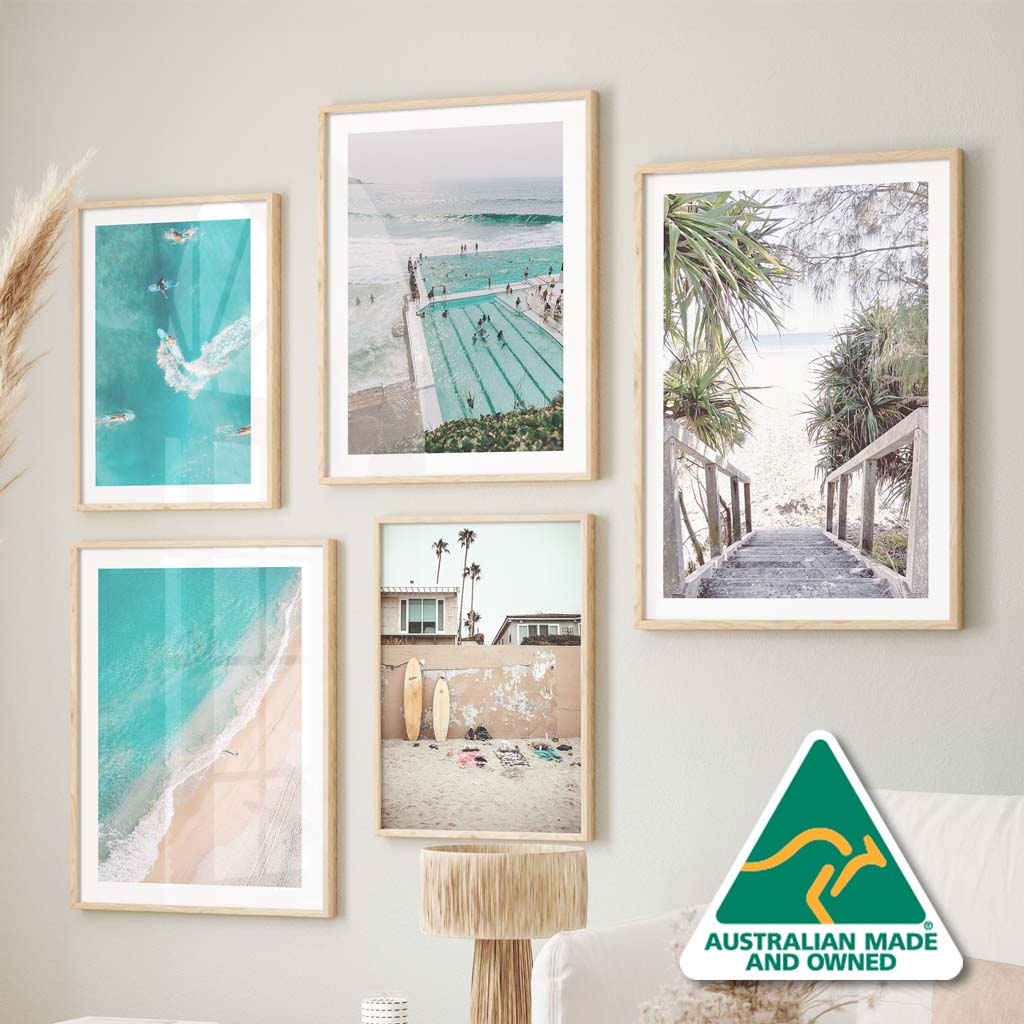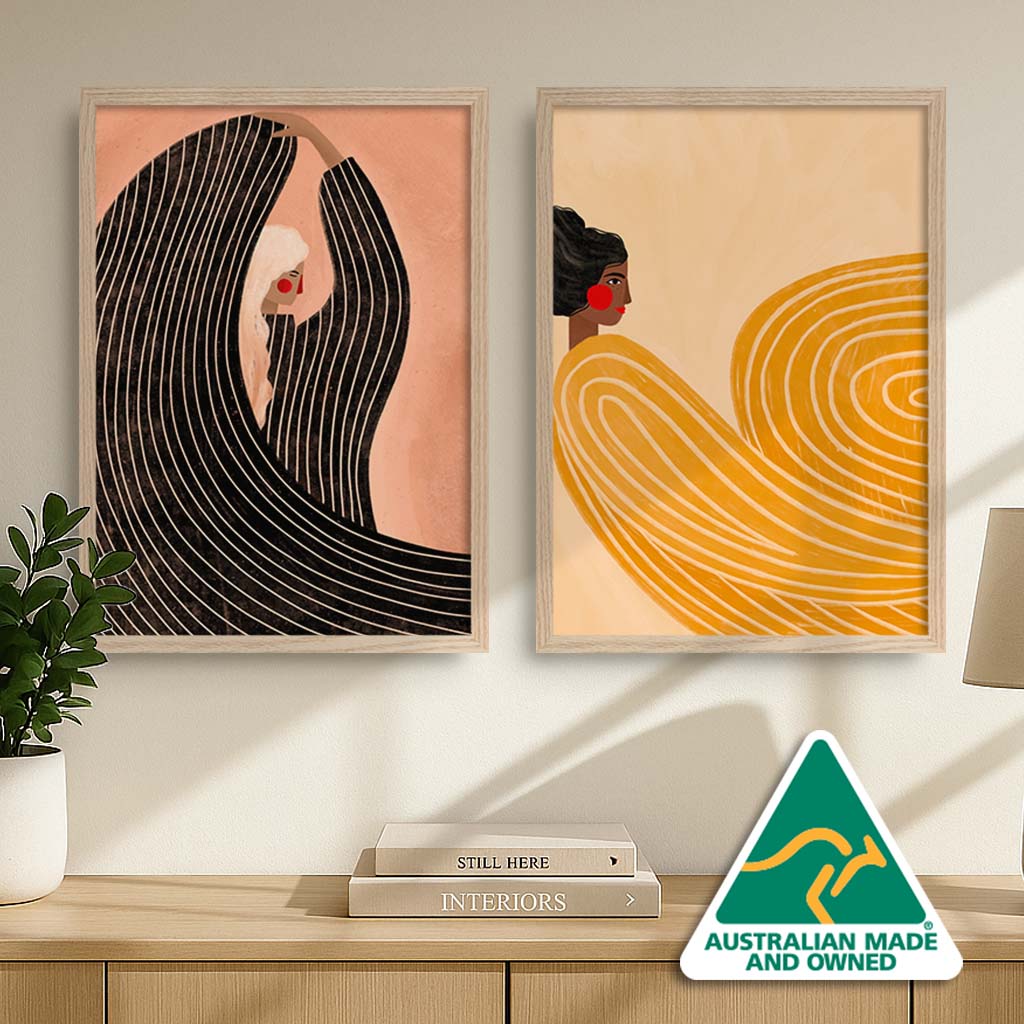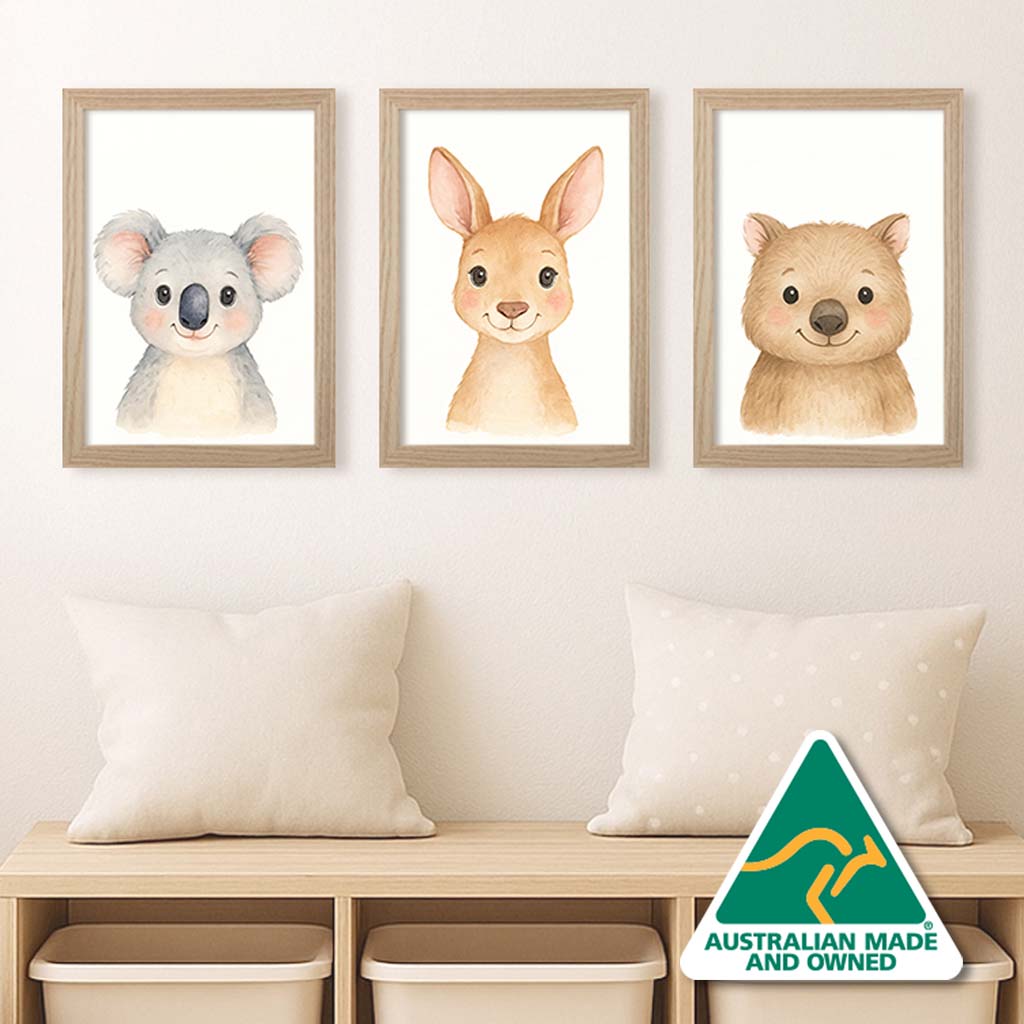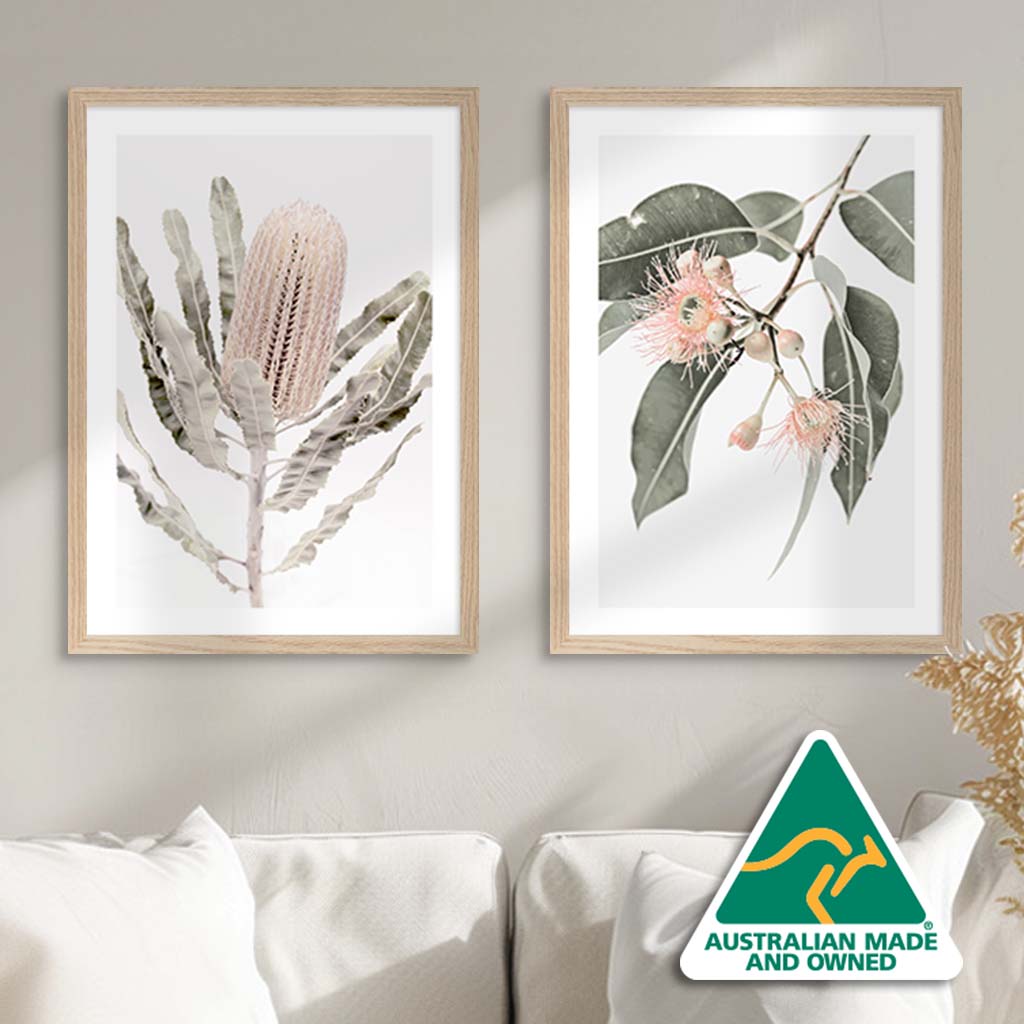Table of Contents
Choosing the right size wall art can feel tricky - how big should it be on the wall? If you’re unsure how to size wall art for a room, you’re not alone. Too small and the art might look lost; too large and it could overwhelm the space.
In this guide, we’ll demystify wall art dimensions with a handy A-series size chart, a quick-reference wall art measurement guide, and room-by-room tips. We answer common questions like “what size wall art should I hang above a bed?” and “how large should art be over a sofa?”, so you can confidently select the perfect framed print for every room in your home. (All examples in this guide refer to Profile Australia's standard A-series framed wall art under glass.)
Standard Wall Art Sizes (A-Series Chart)
When choosing wall art, it’s helpful to understand the A-series sizing system - a global standard also widely used in Australian interiors. Each step up in the A-series doubles the surface area, making it easy to scale up or down while keeping visual proportions consistent.
- A4 (21 x 29.7 cm): Best for compact spaces, shelves, or grouped in gallery layouts.
- A3 (29.7 x 42 cm): Versatile size ideal for hallways, entryways, or small feature walls.
- A2 (42 x 59.4 cm): Great standalone size for bedrooms, home offices, or mid-sized walls.
- A1 (59.4 x 84.1 cm): A bold choice for living rooms or above furniture.
- A0 (84.1 x 118.9 cm): Oversized impact piece, perfect for large blank walls or open-plan areas.
All Profile Australia wall art is framed under gallery-grade acrylic glass, which adds approximately 2-3 cm to each edge. Always account for total framed size when planning your wall layout.
Standard Wall Art Dimensions
| Wall Art Size | Wall Art Print Width | Wall Art Print Height | Framed Wall Art Width | Framed Wall Art Height | Framed Wall Art Depth |
|---|---|---|---|---|---|
| A0 | 118.9cm | 84.1cm | 123cm | 87cm | 3cm |
| A1 | 84.1cm | 59.4cm | 87cm | 62.4cm | 3cm |
| A2 | 59.4cm | 42cm | 62.4cm | 45cm | 3cm |
| A3 | 42cm | 29.7cm | 45cm | 32.7cm | 3cm |
| A4 | 29.7cm | 21cm | 32.7cm | 24cm | 3cm |
General Guidelines for Choosing the Right Size
When choosing the right size wall art for your space, there are a few universal principles that can help simplify the decision. These timeless layout rules ensure your art looks proportionate, polished, and thoughtfully placed - regardless of the room.
-
Proportions Matter (The 2/3 Rule): A helpful rule of thumb is that wall art should span roughly two-thirds the width of the furniture it hangs above. For example, if your sofa is 210 cm wide, a single framed piece or arrangement measuring around 140 cm will feel balanced. This principle also works for beds, sideboards, and consoles.
-
Above Furniture vs. Empty Wall: When hanging art above furniture, such as a couch or bed, apply the 2/3 rule for width, and leave around 20-25 cm of space between the top of the furniture and the bottom of the artwork. For blank walls with no furniture, fill 60-75% of the wall’s width for visual balance.
-
Eye-Level Placement: Art should feel natural when viewed, so the midpoint of a framed print or art arrangement should be about 145-155 cm from the floor-roughly average eye height. If hanging art above furniture, adjust the positioning so it sits closer to the item, not floating too high.
-
Visualise with Tape: This trick works especially well - particularly when arranging multiple pieces or creating a framed gallery wall - and is one of the techniques we highlight in our Ultimate Guide to Hanging Pictures.

Living Room Wall Art: Getting the Size Right
The living room is often the central space in your home, and wall art plays a big role in setting the tone. The size you choose should feel in proportion to the wall and any furniture beneath it, especially your sofa.
-
Above a Sofa: Choose artwork that spans around two-thirds the width of the sofa for balance. A typical 3-seater sofa is about 210 cm wide, so aim for art or an arrangement measuring between 140-160 cm. This could be one large A1 or A0 framed print, or two A2s placed side-by-side. Hang the bottom of the artwork about 20-25 cm above the sofa for a grounded, cohesive look.
-
Focal Walls & Large Spaces: For large feature walls or open-plan living areas, go bold with oversized artwork. A single A0 print makes a dramatic statement, or try a row of three A2 prints for a more structured gallery look. Just remember to maintain consistent spacing and keep the centre of the arrangement near eye level.
See our Living Room Art Collection for framed wall art prints designed to complement your space - whether you're styling a single statement piece above the sofa or building a full gallery wall.
Bedroom Wall Art: Above the Bed
In the bedroom, wall art should enhance the calm and personal feel of the space. The most common location is above the bed, where art acts as a visual anchor for the entire room.
-
Sizing Above a Bed: Select artwork that spans 50-75% of the bed’s width. For a Queen bed (approx. 150-160 cm wide), a centred A2 or A1 framed print works well. For a King bed (approx. 180 cm wide), scale up with an A0 print or use two A2s hung side-by-side for visual impact.
-
Placement & Groupings: Position the bottom of the frame around 15-25 cm above the headboard. The top of the frame should remain at least 15-20 cm below the ceiling to avoid visual crowding. Gallery-style arrangements also work well—try three A3s in a row or a symmetrical pair of A2s for a balanced look.
Explore our Bedroom Art Collection for framed prints that add calm, character, and a personal touch to your space - perfectly proportioned for above the bed or as part of a gallery wall.
Home Office Wall Art Ideas
The home office is where productivity meets personality. Well-placed wall art can inspire creativity and bring character to your workspace without distraction.
- Above a Desk: Mid-sized prints such as A3 or A2 work well above a desk. They're large enough to make an impact but small enough to keep the space focused.
- Zoom-Friendly Backdrops: Consider placing A2 or A3 prints behind your chair as a tidy backdrop for video calls. Choose calming or abstract pieces to avoid visual clutter.
- Creative Corners: A4 prints or grouped A4/A3 sets work well in small office nooks or reading corners. Keep the palette cohesive for a clean and motivating space.
Discover our Office & Study Wall Art for designs that elevate focus, creativity, and balance in any professional or study space.
Other Rooms & Spaces: Dining, Hallway, Kids Rooms, etc.
-
Dining Room: A1 or A0 prints create elegant focal points above a buffet or sideboard. For longer walls, pair two A2s side-by-side for symmetry.
-
Hallways & Entryways: Narrow spaces benefit from vertical art stacks or even framed gallery grid arrangements. Use A3 or A4 prints to create movement along the corridor. Maintain 5-8 cm spacing.
-
Kids Rooms: A3 and A2 prints are ideal for playrooms or nurseries. Use themes like animals, nature, or soft colours to add charm. Position art lower on the wall so it's visible at a child's eye level. Mix in framed drawings or names for a personal touch.
Choosing the Best Wall Art Size for Empty Walls
- Fill a substantial portion of the space: For blank, featureless walls without furniture below, aim to fill about 60-75% of the wall’s width with your artwork.
- Go big in open areas: Large framed prints such as A1 or A0 work well in living rooms, hallways, or stairwells with wide or tall blank walls.
- Consider vertical positioning: Consider height and placement - art should still be centred around eye level (~145-155 cm from the floor).
- Stack or group for tall walls: If the space is especially tall (e.g., stairwells or entry voids), use vertical art or stack smaller pieces to create height.
- Use multiple prints to build width: A series of A3 or A4 prints can also be spaced evenly in a linear or grid arrangement to visually fill space with balance.

From Small to Large - What Size Wall Art Works Best?
Choosing the right size wall art doesn’t have to be confusing. A helpful way to decide is by thinking in size categories - small, medium, large, and oversized - and matching them to your available wall space and room type. Use the reference table below to see how standard A-series sizes align to each category:
Standard Wall Art Sizes
| Small Wall Art Sizes | Medium Wall Art Sizes | Large Wall Art Sizes | Oversized Wall Art Sizes |
|---|---|---|---|
| A4 (21 x 29.7cm) | A3 (29.7 x 42cm) | A1 (59.4 x 84.1cm) | A0 (118.9 x 84.1cm) |
| A3 (29.7 x 42cm) | A2 (42 x 59.4cm) | A0 (118.9 x 84.1cm) |
Where to use Large or Oversized Wall Art
- Ideal for statement pieces in spacious rooms such as living rooms, dining areas, and master bedrooms.
- Best hung above wide furniture (e.g. 3-seater sofas, king-sized beds) where artwork spanning 120-180 cm feels balanced.
- Use A1 or A0 framed prints to fill large wall space, especially when walls are over 3 metres wide.
- Great for creating a dramatic focal point in minimalist or modern interiors.
Where to use Medium Wall Art
- Perfect for versatile placement across most rooms, including bedrooms, offices, and living rooms.
- A2 framed prints (~42 x 59 cm) provide enough impact as standalone pieces while still fitting narrower walls.
- Suitable for above desks, sideboards, or small couches where larger pieces might overwhelm.
- Can also work well as the anchor piece in a framed gallery wall arrangement.
Where to use Small Wall Art
- Best for compact areas like hallways, entryways, powder rooms, or small nooks.
- A4 and A3 framed prints work beautifully in sets, grids, or vertical stacks.
- Excellent for layering into framed gallery walls or shelves (e.g. picture ledges or above side tables).
- Use to fill gaps or provide accent details without overcrowding a space.

Framed Gallery Wall Layout Tips & Ideas
Creating a framed gallery wall is one of the most versatile and visually engaging ways to display art. It allows you to mix frame sizes, artwork styles, and layouts to suit your space and personality.
-
Mix & Match Sizes: Begin with a focal point, such as a larger A2 or A3 framed print, and build around it with smaller A4s. Keeping consistent gaps of 5-8 cm between frames creates a clean, balanced look.
-
Plan the Layout: Before hanging, lay out your frames on the floor or use paper templates on the wall. Aim to follow the two-thirds furniture width rule, especially above sofas, beds or sideboards.
-
Creative Composition: Blend vertical and horizontal orientations. Stick to a colour palette or frame style for cohesion, or contrast styles for a more eclectic vibe. A framed gallery wall should feel intentional, not cluttered.
For more layout inspiration, check out our blog on framed curated Gallery Wall Layout Ideas or try our Picture Frame Wall Hanging Calculator or browse our pre-styled Gallery Wall Frame Sets.

Wall Art Size FAQs: Your Most Common Questions Answered
Still have questions? You're not alone. Below are some of the most commonly searched queries about wall art sizing, answered simply to help you feel more confident.
What size wall art should go above a queen or king bed? Aim for art that spans 50-75% of the bed’s width. For a Queen bed, A2 or A1 works well. For a King bed, consider A1 or A0, or a pair of A2s side by side.
How big should wall art be above a sofa? Use the 2/3 rule: your artwork (or grouping) should be around two-thirds the width of the sofa. That usually means a single A1/A0 or two A2s.
Can I mix wall art sizes in one room? Absolutely. Mixing A4, A3, and A2 prints can add visual interest. Just maintain balance through layout and consistent spacing.
What is the best size for small walls or apartments? A4 and A3 prints are ideal in smaller homes or tight wall spaces. Group them as vertical stacks or grids to make a stylish impact without overcrowding.
What are standard wall art sizes in Australia? The A-series (A4 to A0) is the standard framing format in Australia. These sizes scale proportionally, making it easy to create consistent styling across your home.

Related Reading: More Wall Art Tips & Inspiration
Explore more expert advice to help you style your walls with confidence:
- How to Choose Wall Art for Your Living Room - Discover the best art types, styles, and sizes for lounge spaces.
- Mix & Match: Gallery Wall Layout Tips - Get inspired by layout ideas and composition tricks for framed gallery walls.
- The Ultimate Guide to Hanging Pictures - Learn how to hang art at the perfect height with tools, spacing rules, and more.

Quick-Reference Wall Art Size Chart by Location
Here’s a simple cheat sheet to help you match wall art sizes to the most common wall types and furniture:
| Wall Location | Recommended Size (Framed) |
|---|---|
| Above Queen Bed | A2 or A1 (50-75% bed width) |
| Above King Bed | A1 or A0 or 2 x A2 side-by-side |
| Above 3-Seater Sofa | A1 or A0 (60-75% sofa width) |
| Dining Room Buffet | A1 or 2 x A2 side-by-side |
| Hallway or Entryway | A4 or A3 in vertical arrangement |
| Stairwell or Void | A1 or vertically stacked A2/A3 |
| Small Spaces/Nooks | A4 or grouped A4/A3 prints |

Final Thoughts on Choosing the Right Wall Art Size
Choosing the correct wall art size isn’t just about measurements - it’s about creating harmony within your space. Whether you're styling a minimalist apartment or a large family home, applying simple visual rules like the two-thirds guideline can make a dramatic difference.
The A-series sizing system offers a practical, elegant structure for mixing and matching art that feels balanced and intentional. From oversized A0 statement pieces to A2 gallery sets, there’s a framed size for every room and wall type.
Keep proportions in mind, measure thoughtfully, and don’t be afraid to experiment with layouts using tape or paper templates. With the tips and charts in this guide, you can confidently transform any blank wall into a well-styled focal point.
Ready to frame something new? Explore our range of Australian-Made Wall Art Prints to find the perfect size and style for your space - each one professionally framed and made to suit Australian homes.









